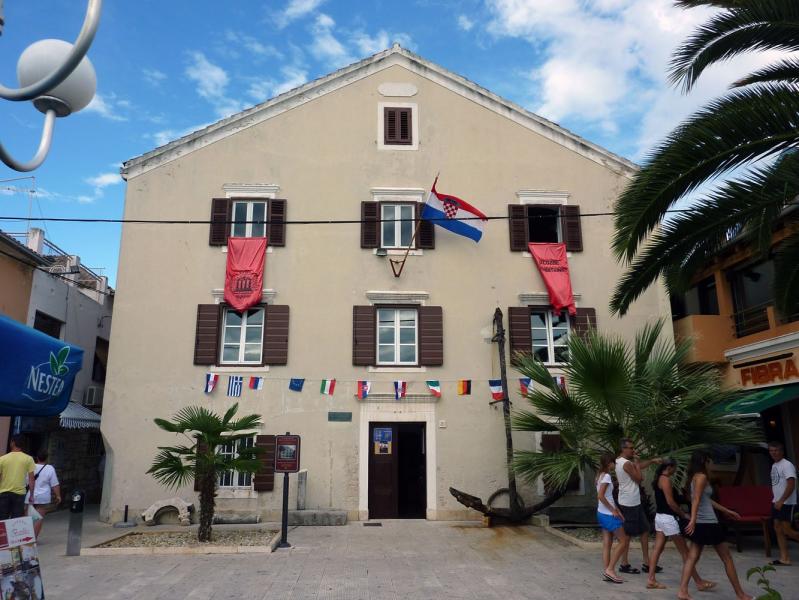
Obala P. Krešimira IV 22
tel./fax - 023/383-721
muzej-biograd.com
The Homeland Museum of the City of Biograd na Moru, is an independent and sole institution of culture in the Biograd area. It preserves the valuable monumental heritage from the rich past of the Biograd coastline and its surroundings.
It is situated in the center of the city, on the waterfront of Biograd, once a royal and crown city, the capital of the Croatian state during the national rulers of the 11th century.
The building in which the Museum is located is a cultural monument. It was built on the ruins of medieval walls in the late 18th and early 19th centuries. The District Court established for Emperor and King Francis Joseph I in 1876 operated in the building for many years.
The Biograd Homeland Museum consist of:
- ARCHEOLOGICAL COLLECTION
- COLLECT OF THE "CARGO OF A SUNKEN VESSEL FROM THE 16TH CENTURY"
- ETNOGRAPHIC COLLECTION
- HISTORY DEPARTMENT
- COLLECTION OF PAINTINGS
The cultural and historic collection "CARGO OF A SUNKEN VESSEL FROM THE 16TH CENTURY" grasps the attention of most of the visitors. It is a unique collection on the Mediterranean and preserves more than 10,000 objects from the sunken vessel in the 16th century.
A Venetian merchant ship loaded to the brim with various expensive goods for trade in the ports of the Mediterranean, sank in 1583 in the Pašman Channel, near the islet of Gnalić, a few miles south of Biograd.
A treasure of inestimable value was hidden at the bottom of the sea, for almost four centuries. It was accidentally discovered by fishermen from the island of Murter only in 1967. Numerous hydro archeological researches have been performed since then and many objects of inestimable value were found. They document the material culture of a relatively new era of which knowledge is now based mainly on written sources and visual representations.
The exhibits can be divided into two groups:
VESSEL EQUIPMENT AND INVENTORY (two big anchors, nine bronze canons, several cannon balls, copper and pewter tableware and more). EXPENSIVE TRADING GOODS TRGOVINU: among the ready-made products the most numerous are glass luxury; glasses, bottles, cups, small vessels, window glass round and cast glass) and small round and rectangular mirrors. According to the fineness and quality of workmanship, it was established that the glass originates from one of the Venetian workshops in Murano. A special group are items made of cobalt glass and dark brown glass and small glass beads in large quantities, of different colors and sizes.
Candlesticks take second place in number and beauty. Two types were found: wall and ceiling - hanging. Unlike the glass objects, these were made in northern Europe, most likely in Lubeck. A large iron chest is perhaps the most striking item from the cargo of a sunken ship. Textile items were stored in it: a bale - a 54 m silk damask roll, three long white shirts and eight woolen hats. All the textile items were cleaned and preserved in the private ABBEGO foundation in Riggesburg near Bern.
Three types of ceramic items were found: simple kitchen utensils, painted majolica and engraved ceramics.
Besides the mentioned items, numerous objects for everyday use were part of the vessel cargo such as: thimbles, sewing needles, pins, razors, glasses, scissors, various types of flags, two precision scales and more.
Raw materials and semi-finished products made up the largest part of cargo by weight and number. Dominated by brass objects in three forms, tin rods (over 1000 kg were removed), 10 balls of cinnabar (weighing over 1000 kg) and lead carbonate - bleach, also in large quantities.
It is significant to point out that brass foils, tin rods, cinnabar, lead carbonate and poeca damask are, as far as is known, absolutely unique. Even though their manufacture was know but until the finding of the cargo, there had been no samples. The permanent exhibition of the Homeland Museum consists of one part of these items according to type, actually 950 items, part of the collection CARGO OF A SUNKEN VESSEL FROM THE 16TH CENTURY". From its founding in 1970 until the present day, the collection has undergone several alterations, i.e. additions to new items as they arrived from conservation.



